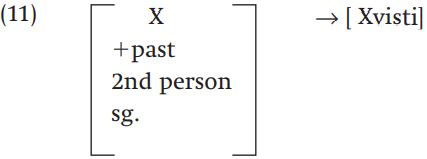
Morphemes as processes and realizational morphology
 المؤلف:
Rochelle Lieber
المؤلف:
Rochelle Lieber
 المصدر:
Introducing Morphology
المصدر:
Introducing Morphology
 الجزء والصفحة:
181-10
الجزء والصفحة:
181-10
 27-1-2022
27-1-2022
 1738
1738
Morphemes as processes and realizational morphology
This is, of course, not the only way of formalizing morphological rules. Indeed, many morphologists believe that it is a mistake to count morphemes as ‘things’ that have their own independent existence in our mental lexicons. The alternative, they argue, is to allow only free morphemes to have lexical entries of their own, and to introduce bound morphemes using rules that contain the phonological form and the semantic content of the bound morpheme. The -ize rule might look like (9) in such a theoretical framework:

In the case of the -ize rule, this may not look terribly different than the lexical entry we proposed above. But consider the sort of rule we would have to propose for an irregular past tense form like sang in English. Since the past tense in this form is created by a process of ablaut, we can propose a rule that changes the vowel [ɪ] to [æ] to produce sang.

If C stands for any consonant, and N for any nasal consonant, we can express the vowel change that takes place in the past tense very simply with such a rule. It is not so easy to see how to express an internal vowel change using the ‘morpheme as thing’ model; it doesn’t seem to make sense to say that the past tense in such verbs is a morpheme that consists of only the vowel [æ]. The sort of theoretical framework that treats morphemes as parts of rules is sometimes called an Item and Process (IP) theory, because morphological rules are conceived as operations or processes that act on free morphemes.
Related to the Item and Process model is the Word and Paradigm (WP) model. WP models are also sometimes known as a realizational models. They are often proposed to account for inflectional word formation in languages that have complex paradigms, especially the sort of paradigm which exhibits a characteristic called multiple exponence. Multiple exponence occurs when particular inflectional characteristics – say past tense, or third person – are signaled by more than one morpheme in a word. For example, in the Latin second person singular past tense verb form amāvisti ‘you-sg loved’ we might say that the root is am and the stem with theme vowel amā. The past tense is signaled by the morpheme -v, and the second person singular morpheme is -isti. But this is not quite correct, because the morpheme -isti is a person/number ending that is only used in the past tense; in some sense, -isti bears the meaning of past tense along with its person/number meaning. The past tense meaning is signaled twice in the word a –māvisti. This is what we mean by multiple exponence. In an IA theory of morphology, multiple exponence is problematic. IA models work best when there is a one-to-one correspondence between morphemes and meanings. In other words, each morpheme expresses one and only one inflectional or derivational meaning. WP or realizational models, on the other hand, do not separate out morphemes into discrete pieces, but rather state rules that associate meanings (single or multiple) with complex forms. For example, a realizational rule for the second person singular past tense form of the verb in Latin might be (11):

The realizational model does not recognize -v and -isti as separate morphemes. Instead, the form amāvisti is conceived as a unit that expresses past tense, second person, and singular number conjointly. The existence of multiple exponence causes no problems in a realizational model, because inflected words need not be segmented into discrete pieces.
 الاكثر قراءة في Morphology
الاكثر قراءة في Morphology
 اخر الاخبار
اخر الاخبار
اخبار العتبة العباسية المقدسة


